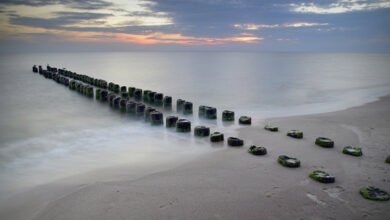Poland, a beautiful European nation, offers diverse landscapes and rich history, making it an excellent destination for scenic road trips. From city breaks to countryside escapes, driving in Poland provides the freedom and flexibility to explore hidden gems at your own pace. However, before you hit the roads, it’s essential to familiarise yourself with the local driving rules and regulations to ensure a safe and enjoyable experience.
For starters, ensure that you have a valid driving licence. Visitors aged 18 and over can legally drive if they hold a full licence. EU and EEA driving licences are accepted, and while international driving permits are recognised, they are not mandatory. When planning your trip, be aware that traffic may be dense, particularly in urban areas. Major highways in Poland are generally well-maintained, but rural roads may be narrow and poorly lit.
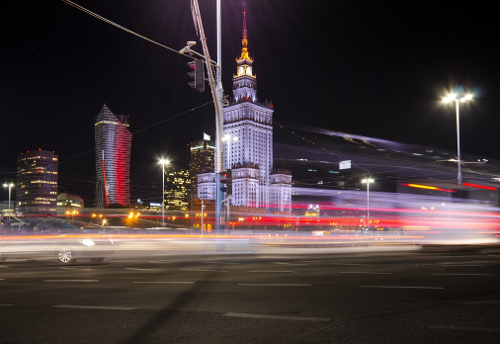
To make your journey through Poland as smooth and stress-free as possible, take some time to acquaint yourself with local road etiquette, speed limits, and road signage. This knowledge, combined with a spirit of adventure, will allow you to confidently navigate Poland’s road network and fully appreciate the nation’s captivating beauty.
Right Drive and Traffic Regulations
When driving in Poland, it’s essential to be aware of the traffic regulations and the correct side of the road.
In this section, you’ll learn about the priority rules, overtaking, and speed limits in Poland.
Priority Rules
In Poland, you must drive on the right side of the road. When it comes to priority, always give way to pedestrians and public transport vehicles like buses and trams.
Buses, in particular, tend to move assertively, so it’s best to let them have the right of way. Furthermore, you must yield to traffic coming from the right at intersections unless road signs indicate otherwise.
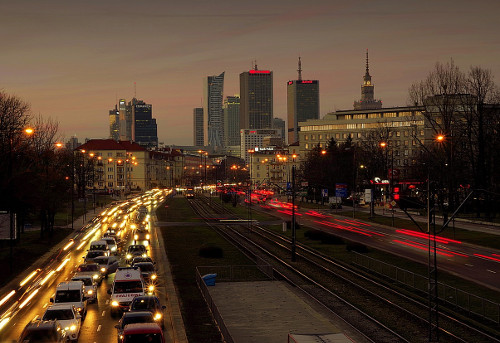
Overtaking
Overtaking in Poland should be done on the left side. Be cautious and judicious when attempting to overtake, ensuring that you have a clear line of sight and a safe distance from the vehicle you’re trying to pass.
It’s illegal to use a handheld mobile device while driving, so avoid distractions and keep your focus on the road.
Speed Limits
Speed limits in Poland vary depending on the type of road and the area. Below is a table showing the typical speed limits in various areas:
| Road Type | Speed Limit |
|---|---|
| Urban Areas | 50 km/h (31 mph) |
| Single Carriageway | 90 km/h (56 mph) |
| Expressways | 100-120 km/h (62-75 mph) |
| Motorways | 140 km/h (87 mph) |
Make sure to adhere to these speed limits and be mindful of any changes in speed limits due to road conditions, construction, or other factors. Also, remember to always wear your seatbelt and have children under 12 sit in the back.
When driving in Poland, it’s crucial to be cautious and abide by traffic regulations to ensure a safe and enjoyable journey.
Safety Measures
Seat Belts
It’s essential to prioritise safety when driving in Poland. As a driver or passenger, you must wear your seat belt at all times. Make sure your seat belts are intact and functioning properly before embarking on your journey.
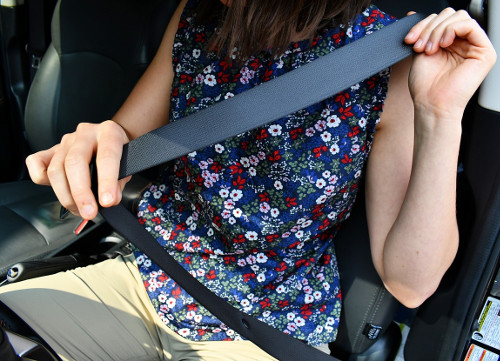
Dipped Headlights
In Poland daytime running lights (dipped headlights in the dark) are compulsory.
Reflective Jacket
Carrying a reflective jacket in your vehicle is highly recommended in case of an emergency, breakdown, or when changing a flat tyre. If you have to step out of your car on the side of a busy road or motorway, wearing a reflective jacket increases your visibility to other drivers, significantly decreasing the risk of accidents.
Warning Triangle
In addition to a reflective jacket, it’s also advisable to carry a warning triangle in your car. In the event of a breakdown or accident, place the warning triangle at a suitable distance behind your vehicle to alert other drivers.
This vital safety measure can prevent further collisions and keep both you and other road users safe.
Road Conditions
Built-Up Areas
When driving in Poland, you will find that traffic conditions in built-up areas are generally manageable.
However, it’s important to be cautious, particularly during peak hours when congestion is common. Remember to strictly follow the local speed limits and always give way to public transport vehicles. In built-up areas, the speed limit is usually 50 km/h.
Rural Roads
As you venture outside of city centres and into more rural areas, the road conditions might become more challenging. Rural roads in Poland can often be narrow, poorly lit, and in some cases, filled with potholes.
It’s crucial to drive cautiously in these areas, especially after dark. In addition, the speed limit on rural roads is typically 90 km/h, but it’s wise to adjust your speed according to the road conditions.
Motorways
Poland’s motorways are generally in good condition and well-maintained. The speed limit on motorways is 140 km/h, but you should always adhere to posted signs since there might be some variations.
Be aware that some motorways have tolls, either payable at booths along the route or through an electronic system.
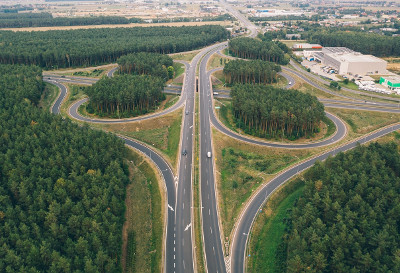
Dual Carriageways
When driving on dual carriageways (express roads), the speed limit varies between 100-120 km/h. These roads are constructed to accommodate higher speeds, so overtaking is done on the left side, as usual. Make sure you’re familiar with the rules and regulations, such as yielding to vehicles entering the carriageway from the right and proper use of lanes for overtaking.
By staying informed about the road conditions and guidelines in Poland, you can safely navigate your way through built-up areas, rural roads, motorways and dual carriageways on your journey.
Hiring and Driving a Rental Car
Car Hire
When planning to rent a car in Poland, it is essential to choose a reputable car rental company. You can find numerous companies like Enterprise and Avis Car Hire that offer their services in the country.
Ensure that you read the terms and conditions of your rental agreement before signing, as different companies may have varying requirements and restrictions.
Always take note of your rental car’s condition and mileage at the time of pick-up, and inform the rental company of any damages or issues to avoid potential disputes later on. Additionally, make sure you are aware of the driving laws in Poland as they may differ from your home country.
Insurance Papers
For a hassle-free driving experience, don’t forget to carry all the necessary insurance documents with you. Your rental car will typically come with basic motor insurance; however, it is a good idea to check the coverage provided in the policy. You can consider purchasing additional coverage, such as comprehensive insurance, from your rental company or a third-party provider for added protection.
Moreover, it is crucial to have your driving license and passport with you when hiring a car in Poland, as the rental company will need to verify your identity and driving qualifications. It’s always a good idea to keep a physical or digital copy of all your documents for easy reference during your trip.
Car Seats
If you are travelling with young children, remember that the appropriate car seat is required by law in Poland. Make sure to inform your rental company about your car seat requirements during the booking process, as they can provide you with the appropriate seat based on your child’s age, height, and weight. Alternatively, you can bring your own car seat with you; however, it must meet the safety standards applicable in Poland.
In conclusion, hiring and driving a rental car in Poland can be a convenient way to explore this beautiful country, provided you properly follow the local driving laws, carry all the required documents, and ensure that necessary safety measures are in place.
Alcohol and Driving
When driving in Poland, it’s crucial to be aware of the country’s rules and regulations surrounding alcohol consumption and driving. Remember that driving under the influence of alcohol is not only dangerous but also illegal.
In Poland, the maximum admissible blood alcohol content (BAC) while operating a vehicle is 0.2 mg per ml. This limit is quite strict compared to some other European countries, so it’s essential for you to be extra careful when consuming alcohol before taking the wheel. It’s always better to err on the side of caution, and if you’re unsure about your alcohol consumption, avoid driving entirely.
If your BAC exceeds 0.5 mg per ml, it’s considered a criminal offence, and you may be punished with up to two years imprisonment. Moreover, the legal consequences of drink-driving have increased in recent years. For instance, in 2015, Poland toughened its penalties for driving under the influence, with offenders now facing a driving ban that ranges from 3 to 15 years, and re-offenders may even face a lifetime driving ban.
When visiting Poland, it’s wise to familiarise yourself with the country’s drink-driving rules and to always prioritise your safety and that of others on the road. Plan ahead, be mindful of your alcohol consumption, and consider alternative transport methods such as taxis, public transportation, or designated drivers when necessary. By adhering to the Polish regulations and promoting responsible drinking, you can contribute to the overall safety on the road and enjoy your stay in this beautiful country.
Polish Law and Driving Non-Compliance
In this section, we will explore the Polish law in relation to driving non-compliance, including fines and imprisonment.
Fines
In Poland, violating traffic rules can result in various fines. For example, if you exceed the speed limit by 50 km/h in a built-up area, your driving licence may be automatically withdrawn for three months. Furthermore, using automatic speed cameras is a common practice in Poland to enforce speed limits.
Speeding: Fines for speeding vary depending on the severity and location of the offense.
- Within built-up areas, exceeding the speed limit by up to 10 km/h results in a fine of up to 100 PLN.
- Exceeding the speed limit by 11 to 20 km/h results in a fine of up to 300 PLN.
- Exceeding the speed limit by 21 to 30 km/h results in a fine of up to 500 PLN.
Equipment: In accordance with Polish law, your car must have a fire extinguisher and a warning triangle. Failure to comply may result in a fine.
Remember that fines are subject to change, and it is always best to familiarise yourself with the current traffic rules and regulations within Poland.
Imprisonment
While most traffic violations result in fines, some severe offences may lead to imprisonment. For instance:
- Driving under the influence of alcohol or drugs is considered a criminal offence and may result in imprisonment, depending on the circumstances.
- Causing a traffic accident that results in injury or death may also lead to imprisonment, particularly if it involves reckless driving or driving under the influence.
It is crucial to adhere to the traffic rules and regulations set forth by Polish law to ensure your safety and the safety of others on the road. Remember that non-compliance with Polish traffic laws may result in fines, imprisonment, or both.
Travel Documents
When driving in Poland, it is crucial to have all the necessary travel documents readily available. This section will provide an overview of the key documents you need, including your driving licence, international driving permit, ETIAS, and visa.
Driving Licence
Before setting off, ensure you have your valid UK driving licence with you. This is essential when driving in Poland and other Schengen countries. Bear in mind your licence must have a ‘date of issue’ less than 10 years before the date you arrive in Poland.
International Driving Permit
In addition to your driving licence, it’s a good idea to have an International Driving Permit (IDP).
While not mandatory, an IDP can serve as an additional form of identification and could be helpful in certain situations, such as when renting a car or interacting with local authorities.
ETIAS
Starting in 2023, UK citizens visiting Poland and other Schengen countries will need to obtain an EU Travel Information and Authorisation System (ETIAS) authorisation.
This online security check must be completed and approved before travelling, and will be valid for three years or until your passport expires, whichever comes first.
Visa
For visits shorter than 90 days within a 180-day period, British citizens do not currently need a visa to enter Poland. However, it is essential to keep your passport up-to-date with an issue date less than 10 years before your arrival. Always double-check the visa requirements before your trip, as these can change.
When driving in Poland, staying compliant with local regulations is key. Remember to have all necessary documents with you—your valid UK driving licence, international driving permit, ETIAS, and passport—to ensure a smooth and trouble-free journey.
Urban Driving
Driving in Warsaw
When driving in Warsaw, remember to adhere to the local regulations and speed limits. In urban areas, you will typically encounter a speed limit of 50 km/h from 5 AM to 11 PM, and 60 km/h from 11 PM to 5 AM.
Keep an eye out for priority road signs, as well as any specific instructions from Polish authorities. Be aware that public transport vehicles have right of way, so be prepared to give way when necessary.
Driving in Krakow
Krakow’s historic centre can be a challenge for drivers due to its narrow streets and heavy traffic.

Make sure you are familiar with the local parking rules, as you may need to use designated parking areas outside the city centre.
Additionally, follow general Polish driving regulations, such as adhering to the speed limits and giving way to public transport vehicles.
Driving in Gdansk
Gdansk, like other Polish cities, has a well-organized road infrastructure. However, driving in the city centre can be a bit of a challenge due to its historic streets.
It is essential to familiarize yourself with the local parking rules, as well as the EU regulations governing driving in Gdansk. Remember to give way to public transport vehicles, and maintain the appropriate speed limits.
Driving in Poznan
Driving in Poznan can be a pleasant experience as long as you abide by the local speed limits and road regulations. In urban areas, the speed limit is 50 km/h from 5 AM to 11 PM and 60 km/h from 11 PM to 5 AM.
Be mindful of any weight restrictions in place to avoid fines, and always give way to public transport vehicles. Ensure you park in designated areas to avoid penalties, and follow the guidance of local Polish authorities where necessary.
Read also:
Seasonal Considerations
Autumn
During autumn in Poland, it is important to remember that your car lights must be on all the time, as this is a legal requirement. You should also be mindful of wet and slippery road conditions due to rainfall, resulting in sometimes unpredictable driving conditions. To ensure your safety and the safety of others:
- Keep a safe distance from the vehicle in front.
- Check your tire tread and pressure regularly.
- Be prepared for sudden weather changes, such as fog or heavy rain.
Winter
Winter driving in Poland can be challenging due to potentially hazardous conditions like snow, ice, and reduced visibility. To stay safe during the winter months, consider the following tips:
- Ensure your car is equipped with winter tyres, as they provide better grip and control in snowy or icy conditions.
- Use caution when navigating around snowploughs or salt spreaders.
- Always clear your windows and mirrors of ice and snow before starting your journey.
- Keep an emergency kit in your car, including items such as a torch, blanket, and first-aid supplies.
Remember that it’s better to take a cautious approach when driving in unfamiliar seasonal conditions; slowing down and allowing extra time for your journey will help keep you safe on Poland’s roads during autumn and winter.
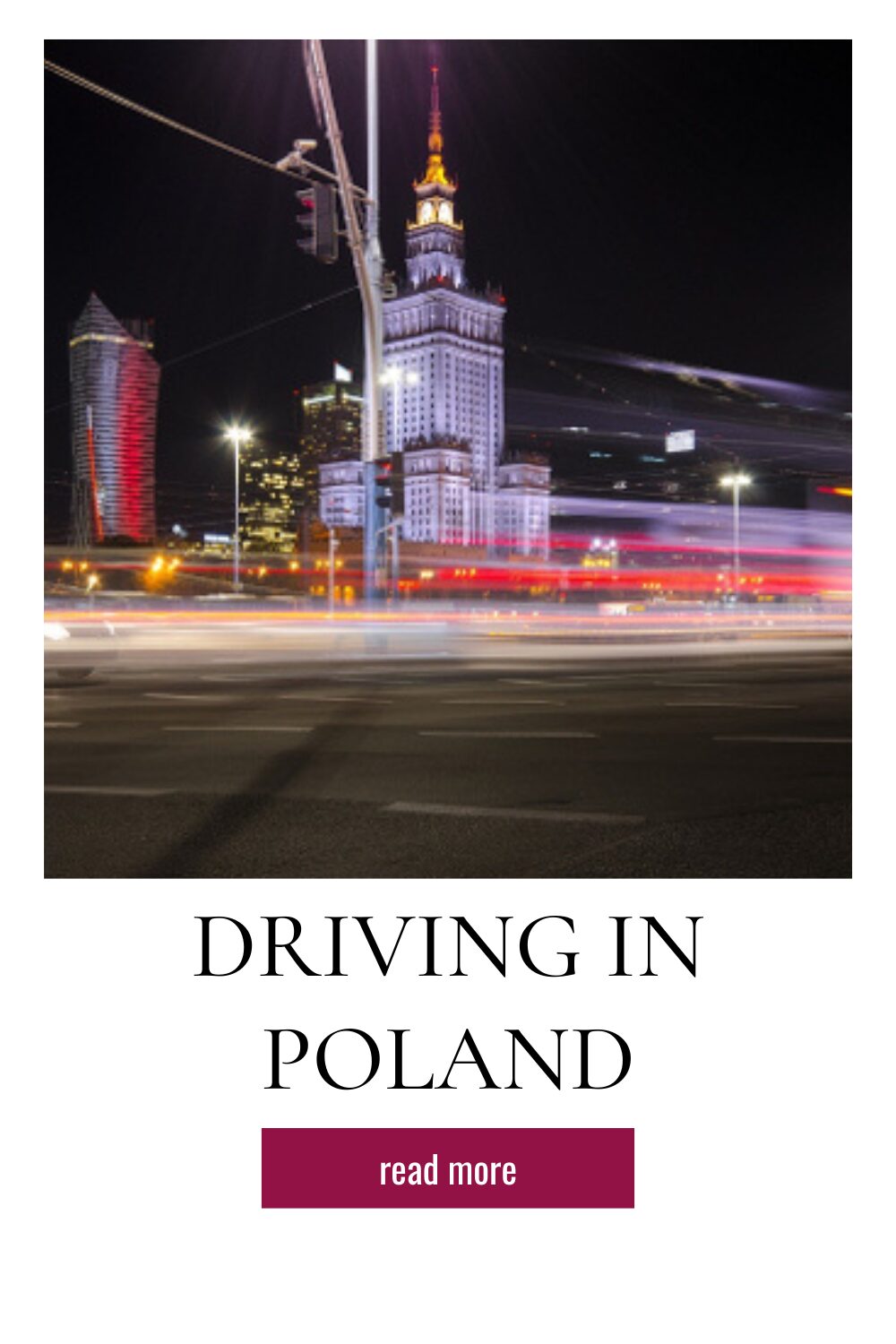
Interactions With Pedestrians and Cyclists
When driving in Poland, you should be particularly cautious around pedestrians and cyclists, as they can be frequently encountered on the roads. In fact, pedestrians account for 25% and cyclists for 10% of road fatalities in the country.
On country roads, you may come across narrow, potholed, and poorly lit sections, which are often shared with pedestrians, cyclists, tractors, and horse-drawn vehicles. It is advisable to avoid these roads if possible, and if not, proceed with caution.
At pedestrian crossings, make sure to abide by the speed limits and be prepared for pedestrians who might not be visible from a distance. In Poland, it has been observed that long pedestrian crossings, vehicles going too fast near crossings, insufficient sight distance, and poorly marked crosswalks pose significant risks to pedestrians.
When you encounter cyclists, maintain a safe distance and be prepared for any sudden movements they may make. Polish roads may not always have dedicated cycle lanes, so be prepared to share road space with cyclists and give them the necessary room to manoeuvre safely.
Finally, bear in mind that driving under the influence of psychoactive substances is strictly forbidden in Poland. Stay within the legal limits to ensure the safety of not only yourself but also pedestrians, cyclists, and other road users.
Managing Delays and Breakdowns
When driving in Poland, it’s essential to be prepared for potential delays and breakdowns. By taking simple precautions and understanding the local regulations, you can minimise your risk and handle any unexpected situation efficiently.
First and foremost, ensure that your vehicle is well-maintained and equipped with necessary items. When driving in Poland, you’re required by law to carry a warning triangle and headlamp beam deflectors. Failure to have these items may result in hefty on-the-spot fines. Furthermore, it’s a good idea to have a first-aid kit, reflective vests, and a spare tyre.
In case of a breakdown, pull over to the side of the road as safely as possible and turn on your vehicle’s hazard lights. Place the warning triangle at an appropriate distance from the rear of your vehicle – around 30 to 50 metres – to warn other drivers of the situation. Put on your reflective vest before stepping out of the car to improve your visibility, especially in low light conditions.
If you require assistance, call the emergency services on 112 or use the dedicated road emergency number 981 for breakdown and towing services. Keep your vehicle documentation ready, including your UK driving licence and proof of ID, such as a passport. Be prepared to share your location and the nature of your vehicle’s problem. It’s also wise to have the contact details of your vehicle insurance provider or breakdown cover provider readily available.
To manage delays, always plan your trip with extra time to account for unforeseen circumstances such as traffic congestion, roadworks, or diversions. Stay informed about road conditions and potential disruptions by checking local news reports, online traffic monitoring services or using a navigation app with real-time traffic information. Be mindful of temporary changes to regulations regarding driving times, breaks, and rest periods for drivers engaged in both domestic and international road transport in Poland, as these can affect your travel schedule.
By being prepared and staying informed, you can handle breakdowns and delays safely and efficiently while driving in Poland.
Travel Insurance and Derived Benefits
When planning your road trip in Poland, it’s important to consider travel insurance. Travel insurance offers a range of protections and benefits, providing financial security and peace of mind during your driving adventure. These policies often cover medical expenses, baggage loss or damage, personal money and belongings, as well as many other benefits.
To ensure comprehensive coverage for driving in Poland, consider selecting a travel insurance policy that includes European breakdown cover. This additional protection helps you stay safe in case of a vehicle breakdown on Polish roads. Prices for single-trip European breakdown cover can start from as little as £6.
While driving in Poland, your car insurance may also offer coverage if it includes the European Union and other countries that follow EU directives. This extended coverage offers added reassurance while driving through Poland and neighbouring countries.
As you compare travel insurance policies for your road trip, remember that each policy is different, with varying guarantees, compensation limits, deductibles, and costs. It is essential to select a policy suited to your specific needs while driving in Poland.
Please keep in mind that standard travel insurance policies usually do not cover travelling against government advice or change of heart. Make sure to review the terms carefully and choose the insurance coverage that matches your requirements.
In summary, travel insurance and derived benefits such as European breakdown cover can greatly enhance your driving experience in Poland, ensuring protection and peace of mind throughout your journey.
Respecting Local Laws and Customs
When driving in Poland, it’s essential to respect local laws and customs to have a safe and enjoyable experience. As a driver, you should be aware of the following regulations:
- You must be at least 18 years old and hold a full, valid driving licence to legally drive in Poland. Motorcycle riders up to 125cc must be at least 16 years old.
- EU and EEA issued driving licences are accepted, while international driving permits are recognised but not required.
- In Poland, you drive on the right-hand side of the road, and overtake on the left.
- Seat belts must be worn by the driver and all passengers. Children under 150 cm tall and weighing less than 36 kg must use appropriate child safety seats.
Some local customs to keep in mind while driving include:
- Be cautious when approaching zebra crossings, as pedestrians have right of way and often cross without waiting for vehicles to stop.
- Speed limits in Poland are generally 50 km/h in urban areas, 90 km/h outside urban areas, 120 km/h on expressways, and 140 km/h on motorways. Keep an eye on speed limit signs, as these can change due to road conditions or construction work.
- It’s considered impolite to honk your horn aggressively. Use your horn only to avoid a potential accident or to bring attention to an immediate danger.
Lastly, remember that Poland has a zero-tolerance policy for drink-driving. The legal blood alcohol limit is 0.02% for drivers, and penalties for exceeding this limit can be severe, including fines, driving bans, and imprisonment. It’s best to avoid consuming any alcohol if you plan to drive – stay safe and follow the local laws and customs while driving in Poland.
Living in Poland as a Foreign Driver
Residence Registration
If you’re a foreigner planning to live and drive in Poland, it’s essential to register your residence. If you stay in Poland for 185 days or more, you should register your stay with the local authorities, including information on your driving licence. Remember that driving licences issued in EU and EEA countries are accepted in Poland.
Tax Obligations
As a foreign driver living in Poland, you’re subject to the country’s tax regulations. It’s crucial to familiarise yourself with the Polish tax system, which consists of both direct and indirect taxes.
Depending on your employment status, you might be required to file a tax return. Be sure to consult a tax advisor to ensure you’re in compliance with all tax obligations.
Pension
Living and working in Poland means that you’re likely to contribute to the Polish pension system. The pension system in the country has three main pillars: the mandatory state pension, mandatory occupational pension, and voluntary private pension schemes.
If you’re an EU citizen, any contributions made to a Polish pension system will also be recognised in your home country’s pension system.
Language Skills
Although many Poles speak English, it’s essential to learn the local language for better communication and understanding of Polish road signs and regulations. Enrol in a language course or practice Polish with locals to improve your language skills.
This will not only help you navigate the roads more confidently but also enhance your overall living experience in the country.
Non-EU Arrangements
Australia
If you hold an Australian driving licence, you can drive in Poland for up to six months. After that, you will need to obtain a Polish driving licence. To do so, you must pass a driving test and provide required documentation, including proof of residency.
Canada
Canadian driving licence holders can use their licence in Poland for up to 180 days. After this period, you must obtain a Polish driving licence by passing a driving test and providing necessary documentation.
New Zealand
New Zealanders can drive in Poland for up to six months with a valid driving licence. After this period, you will need to obtain a Polish driving licence by completing a driving test and submitting required documents.
Belarus
Belarusian driving licence holders can drive in Poland for short-term visits. For longer stays, you must obtain a Polish driving licence by passing a driving test and providing relevant documentation, including proof of residency.
Oman
Omanis can drive in Poland with their valid national driving licence for a short period. For extended stays, you should obtain a Polish driving licence by completing a driving test and providing necessary documentation.
Bulgaria
Bulgarian driving licence holders can drive in Poland without restrictions, as Bulgaria is a member of the European Union and uses EU-standard driving licences.
Switzerland
Swiss driving licence holders can drive in Poland without limitations, as Switzerland and the EU have mutual agreements in place for driving licences.
Gibraltar
Gibraltarian driving licence holders can drive in Poland for short stays without restrictions. For longer stays, you may need to obtain a Polish driving licence by passing a driving test and providing required documents.
Guernsey, Jersey, and Isle of Man
Driving licence holders from Guernsey, Jersey, and the Isle of Man can drive in Poland for up to six months with their valid driving licence. After this period, you must obtain a Polish driving licence through a driving test and required documentation.
Cyprus, Germany, Ireland, Netherlands, Romania, Spain, Sweden
As these countries are members of the European Union, driving licence holders can drive in Poland without restrictions, using their EU-standard driving licences.
Russia
Russian driving licence holders can drive in Poland for short-term visits. For long-term stays, you must obtain a Polish driving licence by completing a driving test and providing necessary documentation.
Ukraine
Ukrainian driving licence holders can drive in Poland for short-term visits. For longer stays, you will need to obtain a Polish driving licence by passing a driving test and providing required documents, including proof of residency.
Frequently Asked Questions
What are the requirements for driving in Poland with a UK licence?
If you hold a valid UK driving licence, you can drive in Poland without any additional permits. However, ensure your licence is up to date and always carry it with you while driving. It is also advisable to have proof of insurance and vehicle registration documents.
Do I need a vignette to drive in Poland?
No, you do not need a vignette to drive in Poland. Instead, some expressways and motorways in Poland operate on a toll system. You will be required to pay the tolls at specific points along these roads.
Can I drive in Poland with an Indian licence?
To drive in Poland with an Indian licence, you will need an International Driving Permit (IDP) in addition to your valid Indian driving licence. Make sure to have both documents with you when driving in Poland.
Start Planning Your Krakow Trip Now!
- Unsure where to stay in Krakow? Discover top-rated Old Town and Kazimierz hotels with Booking.com.
- Book your airport transfer now and enjoy a hassle-free ride directly to your hotel. Driver will meet you at John Paul II International Airport Kraków–Balice.
- Take a Tour of Auschwitz. Arrange a visit to the Auschwitz-Birkenau Memorial and Museum to pay tribute and learn about this significant historical site.
⚠️ SUMMER BOOKING ALERT: Auschwitz tours are in high demand during the busy summer season. Secure your visit now to guarantee your preferred date and time slot. Last-minute availability cannot be guaranteed during this peak season. Due to increased visitor numbers in summer, it’s strongly recommended to book your tickets and tour to Auschwitz well in advance to secure your preferred dates and times! 🔖
- Explore the Fascinating Wieliczka Salt Mine! Book your guided tour today. These tours are very popular, so book early to avoid disappointment and ensure your spot.
- Looking for ideas? Check out our KrakowTOP.org recommended itineraries, including the famous Christmas Market, holiday events, and must-see Krakow attractions like Wawel Castle, Oskar Schindler’s Factory and St. Mary’s Basilica.
What are the tolls like driving in Poland?
Tolls in Poland vary depending on the length of road you are travelling on. Payments can be made in cash, by credit/debit card, or through an electronic toll collection (ETC) system. It is essential to keep your receipt as proof of payment while using toll roads.
Is it safe to drive in Poland during winter?
Driving in Poland during winter can be challenging due to snow, ice, and reduced visibility. However, it is safe if you take necessary precautions. Ensure your vehicle is well-maintained, use winter tyres, and adjust your speed according to the road conditions. Be aware that some roads might be closed due to extreme weather conditions.
What are the driving conditions like in Warsaw?
Driving conditions in Warsaw can be similar to those in other European cities. Traffic can be dense during peak hours, and finding parking might be challenging. Familiarise yourself with local traffic rules, such as giving way to public transport vehicles and adhering to the speed limits. Pay attention to road signs, and be prepared for roadworks or detours in some areas.







